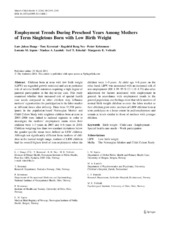| dc.contributor.author | Hauge, Lars Johan | en_US |
| dc.contributor.author | Kornstad, Tom | en_US |
| dc.contributor.author | Nes, Ragnhild Bang | en_US |
| dc.contributor.author | Kristensen, Petter | en_US |
| dc.contributor.author | Irgens, Lorentz M. | en_US |
| dc.contributor.author | Landolt, Markus A. | en_US |
| dc.contributor.author | Eskedal, Leif Torvald | en_US |
| dc.contributor.author | Vollrath, Margarete E. | en_US |
| dc.date.accessioned | 2015-03-17T13:52:17Z | |
| dc.date.available | 2015-03-17T13:52:17Z | |
| dc.date.issued | 2014-11 | eng |
| dc.identifier.issn | 1092-7875 | |
| dc.identifier.uri | https://hdl.handle.net/1956/9554 | |
| dc.description.abstract | Children born at term with low birth weight (LBW) are regarded growth restricted and are at particular risk of adverse health outcomes requiring a high degree of parental participation in the day-to-day care. This study examined whether their increased risk of special health care needs compared to other children may influence mothers’ opportunities for participation in the labor market at different times after delivery. Data from 32,938 participants in the population-based Norwegian Mother and Child Cohort Study with singleton children born at term in 2004–2006 were linked to national registers in order to investigate the mothers’ employment status when their children were 1–3 years in 2007 and 4–6 years in 2010. Children weighing less than two standard deviations below the gender-specific mean were defined as LBW children. Although not significantly different from mothers of children in the normal weight range, mothers of LBW children had the overall highest level of non-employment when the children were 1–3 years. At child age 4–6 years on the other hand, LBW was associated with an increased risk of non-employment (RR 1.39: 95 % CI 1.11–1.75) also after adjustment for factors associated with employment in general. In accordance with employment trends in the general population, our findings show that while mothers of normal birth weight children re-enter the labor market as their children grow older, mothers of LBW children born at term participate to a lesser extent in paid employment and remain at levels similar to those of mothers with younger children. | en_US |
| dc.language.iso | eng | eng |
| dc.publisher | Springer | eng |
| dc.relation.uri | http://download.springer.com/static/pdf/732/art%253A10.1007%252Fs10995-014-1468-1.pdf?auth66=1421157623_7a26ee9c9ace445150f6d84c0df1c000&ext=.pdf | eng |
| dc.rights | Attribution CC BY | eng |
| dc.rights.uri | http://creativecommons.org/licenses/by/4.0 | eng |
| dc.subject | Birth weight | eng |
| dc.subject | Child care | eng |
| dc.subject | Employment | eng |
| dc.subject | Special health care needs | eng |
| dc.subject | Work participation | eng |
| dc.title | Employment Trends During Preschool Years Among Mothers of Term Singletons Born with Low Birth Weight | en_US |
| dc.type | Peer reviewed | |
| dc.type | Journal article | |
| dc.date.updated | 2015-03-05T08:03:12Z | en_US |
| dc.description.version | publishedVersion | en_US |
| dc.rights.holder | Copyright 2014 The Authors | |
| dc.identifier.doi | https://doi.org/10.1007/s10995-014-1468-1 | |
| dc.identifier.cristin | 1142669 | |
| dc.source.journal | Maternal and Child Health Journal | |
| dc.source.40 | 18 | |
| dc.source.14 | 9 | |
| dc.source.pagenumber | 2195-2201 | |
| dc.subject.nsi | VDP::Medical sciences: 700::Health sciences: 800::Community medicine, social medicine: 801 | eng |
| dc.subject.nsi | VDP::Medisinske fag: 700::Helsefag: 800::Samfunnsmedisin, sosialmedisin: 801 | nob |

